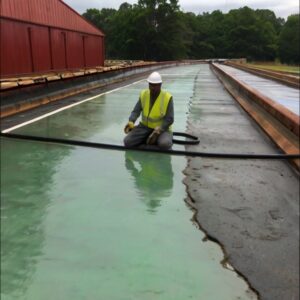The world of infrastructure maintenance and rehabilitation is evolving, with new materials and technologies paving the way for more efficient, durable, and cost-effective solutions. Among these innovations, polyurea stands out as a prime candidate for addressing a wide range of repair issues, from roads and bridges to water systems and buildings.
Road and Bridge Rehabilitation
The rehabilitation of roads and bridges is an ongoing concern, as these structures are continuously exposed to relentless degradation due to heavy traffic, various environmental factors such as temperature fluctuations and moisture, as well as the inevitable toll taken by time. In addressing these challenges, the application of polyurea coatings has emerged as a highly effective solution. Polyurea, when applied to surfaces, forms a durable, protective layer that significantly enhances resistance against various forms of damage including cracks, potholes, and corrosion. This augmented resilience extends the operational lifespan of roads and bridges, making them safer and more reliable over a longer period, and reduces the frequency and urgency of repair work.
Water System Upgrades
The upgrading of water containment systems, encompassing reservoirs, pipes, and sewage systems, is significantly enhanced through the utilization of polyurea coatings. These innovative coatings serve a dual purpose; they prevent leaks by sealing potential breach points within the system, thereby preserving the integrity and reliability of water containment, and offer a formidable shield against corrosion. Corrosion is a common challenge in water systems, often leading to the deterioration of materials and the eventual need for costly repairs or replacements. By applying polyurea coatings, these systems gain a robust layer of protection, ensuring their efficient operation and extending their service life considerably. This proactive approach to maintenance with polyurea coatings means that water systems can remain in peak condition for longer periods, reducing the need for significant overhauls and ensuring the continuous supply of clean, uncontaminated water. The application of polyurea coatings in water system upgrades represents an essential investment in the sustainability and reliability of critical infrastructure.
Building Protection

Buildings, regardless of their purpose—be it for commercial or residential use—demand regular maintenance to maintain both their structural integrity and aesthetic appeal. This maintenance is important to ensure the safety and comfort of the occupants and to preserve the value of the property. Polyurea coatings emerge as a versatile solution in this context, adaptable for application on various surfaces including floors, walls, and roofs. When applied, polyurea forms a seamless, waterproof barrier that significantly enhances the durability of these surfaces. This protective layer is resilient against a wide range of environmental stressors such as UV radiation, temperature fluctuations, and moisture, all of which can contribute to the degradation of building materials over time. In addition to protecting against external elements, the nature of polyurea coatings also means they can withstand the rigors of day-to-day use, from foot traffic on floors to the impact of debris on roofs, without compromising the building’s integrity or appearance. By incorporating polyurea into building maintenance practices, property owners can ensure a higher level of protection for their investments, resulting in structures that remain functional and visually appealing for years to come. This safeguards the immediate well-being of those who use the buildings and contributes to the long-term sustainability and resilience of built environments.
The Application Process
Understanding how polyurea is applied is crucial for those considering its usage for infrastructure repairs. The process typically involves the following steps:
- Surface Preparation: the target area must be cleaned and prepared to ensure proper adhesion. This preparation often involves removing existing coatings, debris, and contaminants.
- Priming: depending on the substrate and the specific type of polyurea used, a primer may be necessary to enhance bonding.
- Application: polyurea is applied using specialized spray equipment that heats and mixes the components at high pressure, ensuring a uniform and seamless coating.
- Curing: after application, the polyurea begins to cure rapidly, reaching full strength within a short timeframe.
Advantages Over Traditional Materials
When evaluating the efficiency and effectiveness of repair and maintenance materials, polyurea stands out significantly when juxtaposed with traditional materials such as concrete, epoxy, or fiberglass. One of the most notable advantages of polyurea is its rapid curing speed. Unlike other materials that may take hours or even days to fully cure, polyurea coatings can set and become functional within minutes. This attribute is beneficial in scenarios where time is of the essence, such as in high-traffic environments including roads, bridges, and commercial buildings, where prolonged disruptions can lead to congestion, reduced accessibility, and potential financial losses.
In terms of performance, polyurea exhibits superior characteristics that make it a more viable option compared to its conventional counterparts. Its remarkable resistance to a wide array of chemicals ensures that surfaces coated with polyurea remain unaffected by spills that would otherwise damage or degrade other materials. Polyurea’s waterproof nature and resilience to physical impacts provide an added layer of protection against environmental stressors and mechanical damage, further asserting its superiority in durability tests.
Ideal Projects for Polyurea Use
Although polyurea is a versatile material, certain projects are particularly well-suited to its properties:
- High-Traffic Areas: for roads, bridges, and commercial floors, where durability and minimal downtime are paramount.
- Harsh Environments: facilities exposed to chemicals, extreme temperatures, or heavy wear can benefit from polyurea’s resilient nature.
- Water-Sensitive Projects: its waterproof characteristics make polyurea ideal for water systems, roofs, and buildings in moist climates.
